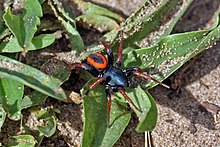| Psammorygma | |
|---|---|

| |
| P. aculeatum | |
| Scientific classification | |
| Domain: | Eukaryota |
| Kingdom: | Animalia |
| Phylum: | Arthropoda |
| Subphylum: | Chelicerata |
| Class: | Arachnida |
| Order: | Araneae |
| Infraorder: | Araneomorphae |
| Family: | Zodariidae |
| Genus: | Psammorygma Jocqué |
| Type species | |
| Psammorygma caligatum | |
| Species | |
| |
Psammorygma is a genus of African ant spiders found in the deserts of southern Africa, namely the Kalahari Desert and the Namib Desert. They are somewhat larger spiders, growing up to twenty millimeters in length. The carapace and chelicerae are brightly colored, while the legs and abdomen are generally a darker black or gray. They can be distinguished from other genera by a knob-like proximal extension found on the cheliceral fang and a double row of dorsal spines in a specific location. First described in 1991 by Jocqué, the name is from the Greek psammon, meaning "sand", and orugma, meaning "mine", in reference to the sandy tunnels these spiders live in. As of February 2019, it contains only three species: P. aculeatum, P. caligatum, and P. rutilans.
References
- ^ "Zodariidae". World Spider Catalog. Natural History Museum Bern. Retrieved 2019-03-05.
- ^ Jocqué, R. (1991). "A generic revision of the spider family Zodariidae (Araneae)". Bulletin of the American Museum of Natural History. 201: 125–128.
| Taxon identifiers | |
|---|---|
| Psammorygma | |
This Zodariidae-related article is a stub. You can help Misplaced Pages by expanding it. |